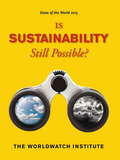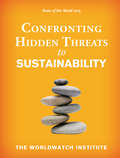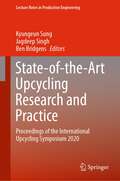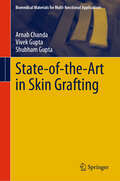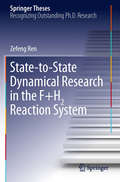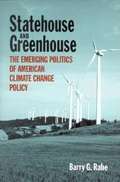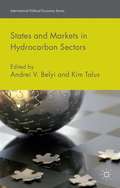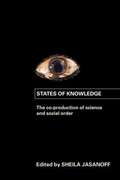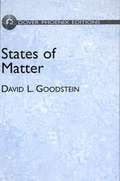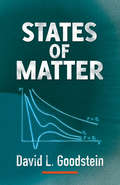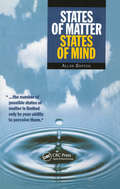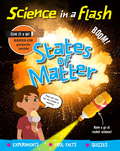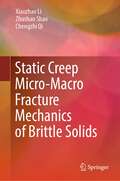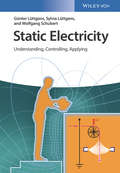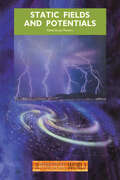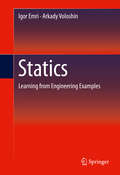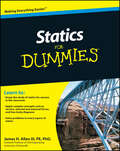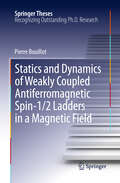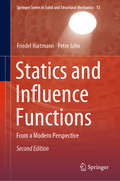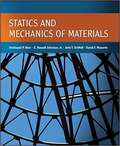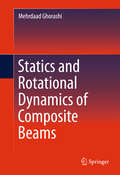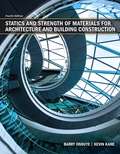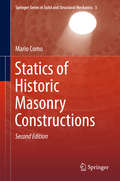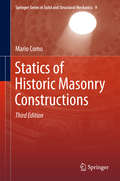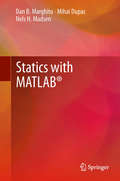- Table View
- List View
State of the World 2013: Is Sustainability Still Possible?
by The Worldwatch InstituteEvery day, we are presented with a range of "sustainable" products and activities--from "green" cleaning supplies to carbon offsets--but with so much labeled as "sustainable," the term has become essentially sustainababble, at best indicating a practice or product slightly less damaging than the conventional alternative. Is it time to abandon the concept altogether, or can we find an accurate way to measure sustainability? If so, how can we achieve it? And if not, how can we best prepare for the coming ecological decline? In the latest edition of Worldwatch Institute's State of the World series, scientists, policy experts, and thought leaders tackle these questions, attempting to restore meaning to sustainability as more than just a marketing tool. In State of the World 2013: Is Sustainability Still Possible?, experts define clear sustainability metrics and examine various policies and perspectives, including geoengineering, corporate transformation, and changes in agricultural policy, that could put us on the path to prosperity without diminishing the well-being of future generations. If these approaches fall short, the final chapters explore ways to prepare for drastic environmental change and resource depletion, such as strengthening democracy and societal resilience, protecting cultural heritage, and dealing with increased conflict and migration flows. State of the World 2013 cuts through the rhetoric surrounding sustainability, offering a broad and realistic look at how close we are to fulfilling it today and which practices and policies will steer us in the right direction. This book will be especially useful for policymakers, environmental nonprofits, and students of environmental studies, sustainability, or economics.
State of the World 2015: Confronting Hidden Threats to Sustainability
by The Worldwatch InstituteWe think we understand environmental damage: pollution, water scarcity, a warming world. But these problems are just the tip of the iceberg. Food insecurity, financial assets drained of value by environmental damage, and a rapid rise in diseases of animal originare among the underreported consequences of an unsustainable global system. In State of the World 2015, the flagship publication of The Worldwatch Institute, experts explore hidden threats to sustainability and howto address them. How will nations deal with migration as climate change refugees cross borders in order to escape flooding, drought, or other extreme weather events? What will happen to the price and availability offossil energy--the foundation of industrial civilization--as these resources oscillate between surplus and scarcity? If perpetual economic growth on a finite planet is impossible, what are the alternatives? Can national governments manage the transition?Eight key issues are addressed in depth,along with the central question ofhow we can develop resilience to these and other shocks. For decades, The Worldwatch Institute has been a leader in identifying and analyzing emerging environmental threats. With the latest edition of State of The World, the authorities at Worldwatch bring to light challenges we can no longer afford to ignore.
State-of-the-Art Upcycling Research and Practice: Proceedings of the International Upcycling Symposium 2020 (Lecture Notes in Production Engineering)
by Jagdeep Singh Kyungeun Sung Ben BridgensThis book presents the proceedings of the first International Upcycling Symposium 2020, held on 4th September 2020 at De Montfort University (DMU) in Leicester, UK (online), as a joint effort between DMU, Lund University, Nottingham Trent University and Newcastle University. This book presents state of the art of research and practice in “upcycling” at the international level.The subject of this book, upcycling, is a term to describe the processes of creating or modifying a product from used or waste materials, components and products, which is of equal or higher quality or value than the compositional elements. This book describes new theories, approaches and scientific research findings related to upcycling and presents examples of upcycling practice, across multiple sectors, scales and contexts. Bringing together research from over 35 multidisciplinary experts, the book discusses state-of-the-art knowledge and practices on upcycling in different geographical, economic, socio-cultural and technological contexts at an international level. Readers will gain fundamental understanding of upcycling with its varied definitions and forms across sectors and scales, and to be informed of the latest upcycling research and practices including valuable ideas, theories, projects, experiences and insights by global experts.
State-of-the-Art in Skin Grafting (Biomedical Materials for Multi-functional Applications)
by Vivek Gupta Arnab Chanda Shubham GuptaThis book discusses the different skin grafting methods, latest trends in graft designing, and its relationship with the burn injuries. An introduction to several conventional and modern skin grafting methods and how crucial the innovation is for recovery of large burns will be presented. The technologies involved in the development of skin grafts incisions, and study of their effect on the mechanical properties and systematically modified skin graft patterns, will be covered at length. The development of skin grafts using conventional, auxetic, and hierarchical patterns through computational and experimental frameworks will be discussed in detail. Also, the role of skin graft patterns on the mechanical stresses, expansion ratio or meshing ratio, will be presented. Additionally, the role of degree of burn, size of burn, and region of burn will be discussed, and its generalizability will be covered in detail. Finally, the challenges with the existing skin graft meshers and latest development in this niche area will be highlighted. This book is anticipated to serve as a key reference for medical and research professionals working in the skin grafting domain as well as the product manufacturing industries. For example, skin grafting plays an important role to cure the serious burn injuries. Current innovative skin graft patterns which cover higher area compared to traditional skin graft patterns are anticipated to help in surgery and faster recovery of larger burnt areas. Also, the current skin graft mesher, which is used to develop traditional skin grafts, cannot produce claimed expansions clinically. This book helps design novel mesher devices to reduce the difference between actual and claimed expansions clinically and increase the skin graft coverage area to recover burn sites with lesser available skin. This book is equally useful for students of medical practices, manufacturing engineering, and design engineering.
State-to-State Dynamical Research in the F+H2 Reaction System
by Zefeng RenThis thesis addresses two important and also challenging issues in the research of chemical reaction dynamics of F+H2 system. One is to probe the reaction resonance and the other is to determine the extent of the breakdown of the Born-Oppenheimer approximation (BOA) experimentally. The author introduces a state-of-the-art crossed molecular beam-scattering apparatus using a hydrogen atom Rydberg "tagging" time-of-flight method, and presents thorough state-to-state experimental studies to address the above issues. The author also describes the observation of the Feshbach resonance in the F+H2 reaction, a precise measurement of the differential cross section in the F+HD reaction, and validation of a new accurate potential energy surface with spectroscopic accuracy. Moreover, the author determines the reactivity ratio between the ground state F(2P3/2) and the excited state F*(2P1/2) in the F+D2 reaction, and exploits the breakdown of BOA in the low collision energy.
Statehouse and Greenhouse: The Emerging Politics of American Climate Change Policy
by Barry G. RabeNo environmental issue triggers such feelings of hopelessness as global climate change. Many areas of the world, including regions of the United States, have experienced a wide range of unusually dramatic weather events recently.
States and Markets in Hydrocarbon Sectors
by Andrei V. Belyi Kim TalusResearch on the role of states and markets in the hydrocarbon sector is highly topical in contemporary International Political Economy. This edited collection will approach this subject from a broader perspective, investigating the very essence of the interaction between the state and the market and how this varies on a regional basis.
States of Knowledge: The Co-Production of Science and the Social Order
by Sheila JasanoffIn the past twenty years, the field of science and technology studies (S&TS) has made considerable progress toward illuminating the relationship between scientific knowledge and political power. These insights are now ready to be synthesized and presented in forms that systematically highlight the connections between S&TS and other social sciences. This timely collection of essays by leading scholars in the field meets this challenge. The book develops the theme of 'co-production', showing how scientific knowledge both embeds and is embedded in social identities, institutions, representations and discourses. Accordingly, the authors argue, ways of knowing the world are inseparably linked to the ways in which people seek to organize and control it. Through studies of emerging knowledges, research practices and political institutions, the authors demonstrate that the idiom of co-production importantly extends the vocabulary of the traditional social sciences, offering fresh analytic perspectives on the nexus of science, power and culture.
States of Matter
by David L. GoodsteinOverview covers thermodynamics and statistical mechanics; gases, solids, and liquids; perfect gases; electronics in metals; and the Bose condensation. Also: structure of a fluid, potential energy, interacting gases and liquids, Weiss molecular field theory, van der Waals equation, and other pertinent aspects of phase transitions. 154 figures .1975 edition.
States of Matter (Dover Books on Physics)
by David L. GoodsteinThis unique overview by a prominent CalTech physicist provides a modern, rigorous, and integrated treatment of the key physical principles and techniques related to gases, liquids, solids, and their phase transitions. No other single volume offers such comprehensive coverage of the subject, and the treatment consistently emphasizes areas in which research results are likely to be applicable to other disciples.Starting with a chapter on thermodynamics and statistical mechanics, the text proceeds to in-depth discussions of perfect gases, electrons in metals, Bose condensation, fluid structure, potential energy, Weiss molecular field theory, van der Waals equation, and other pertinent aspects of phase transitions. Many helpful illustrative problems appear at the end of each chapter, and annotated bibliographies offer further guidance.
States of Matter, States of Mind
by Allan F.M. BartonStates of Matter, States of Mind is an easy-to-read introduction to the way the physical world is put together and stays together. The book presents the fundamental ideas and particles of the makeup of the universe to enable understanding of matter and why it behaves in the way it does. Written in an engaging manner, the book explains some of the intricate details and grand schemes of life and the universe, by making analogies with common everyday examples. For example, the recipe for a cake tells us nothing of how good the cake tastes, but is a model of the food, and a scientific model is no closer to the reality of the materials than a recipe is to the mouth-watering flavor of the cake. Illustrated with helpful cartoons, this book provides a vast knowledge of atoms and atmospheres. The first several chapters introduce terms and fundamental ideas while later chapters deal successively with particles and systems, from the electron to the universe as a system. Each new idea introduced builds upon the last. A user-friendly bibliography provides references for further reading.
States of Matter: Rocks Science ... In A Flash: Rocks (Science in a Flash #35)
by Georgia Amson-BradshawHelp kids discover science - in a flash!What's the matter? Are you in a state over evaporation and condensation? Don't worry - this book will give you the low-down on liquids, a summary about solids and the goods on gases ... and more!This essential KS2 series for children aged 7 and up covers all the key science topics in energetic, quick-fire way, aiding clear comprehension by getting straight to the point! Each spread starts with a 'flash' or headline, summing-up succinctly the science information to follow. Attractive and light-hearted illustration visually conveys the information, adding depth and detail to engage children. Also includes fun jokes and cartoons to keep even the most reluctant readers entertained.
Static Creep Micro-Macro Fracture Mechanics of Brittle Solids
by Xiaozhao Li Zhushan Shao Chengzhi QiThis book gathers a large amount of recent research results on this topic to better understand the static creep micro–macro fracture mechanics in brittle solids (e.g., glass, ceramic, concrete, ice, and rock). To be precise, this is about to explore the effects of the external factors of stress paths, water content, seepage pressure, dynamic disturbance, thermal treated temperature, and the internal factors of crack angle, size, recovery, and nucleation coalescence on the static creep fracture mechanical properties in brittle solids. This book provides important theoretical support in evaluation for long-term lifetime in the brittle solid engineering (e.g., deep underground engineering, architecture engineering, aerospace engineering, and mechanical manufacturing engineering).
Static Electricity: Understanding, Controlling, Applying
by Günter Lüttgens Sylvia Lüttgens Wolfgang SchubertWritten by world-renowned experts on the topic with many years of research and consultancy experience, this invaluable book provides the practitioners' perspective, outlining the dangers and benefits of static electricity in industry. The first chapter reviews the fundamentals of understanding fires and explosions in general and electricity-induced ignition in particular, while the following chapter is dedicated to the origins of static electricity in industrial settings, such as in flowing gases and the transport of disperse systems. The major part of the text deals with measuring static electricity, elimination of unwanted charges and hazard prevention under different conditions. It concludes with an overview of practical applications in chemical and mechanical engineering. Throughout the book, real-life case studies illustrate the fundamental aspects so as to further an understanding of how to control and apply static electricity and thus reduce material damages as well as increase occupational safety. Plus additional movie sequences on the dedicated website showing static electricity in action.
Static Fields and Potentials
by Joy MannersStatic Fields and Potentials describes two of the fundamental interactions in nature: gravity and electromagnetism. The book introduces the associated fields, potentials, and energies and explains the relationship among them. It shows how these interactions manifest themselves in different ways, from the formation of stars to the operation of thund
Statics
by Igor Emri Arkady VoloshinThis textbook introduces and explains the basic concepts on which statics is based utilizing real engineering examples. The authors emphasize the learning process by showing a real problem, analyzing it, simplifying it, and developing a way to solve it. This feature teaches students intuitive thinking in solving real engineering problems using the fundamentals of Newton's laws. This book also: · Stresses representation of physical reality in ways that allow students to solve problems and obtain meaningful results · Emphasizes identification of important features of the structure that should be included in a model and which features may be omitted · Facilitates students' understanding and mastery of the "flow of thinking" practiced by professional engineers
Statics For Dummies
by James H. Allen III PeThe fast and easy way to ace your statics course Does the study of statics stress you out? Does just the thought of mechanics make you rigid? Thanks to this book, you can find balance in the study of this often-intimidating subject and ace even the most challenging university-level courses. Statics For Dummies gives you easy-to-follow, plain-English explanations for everything you need to grasp the study of statics. You'll get a thorough introduction to this foundational branch of engineering and easy-to-follow coverage of solving problems involving forces on bodies at rest; vector algebra; force systems; equivalent force systems; distributed forces; internal forces; principles of equilibrium; applications to trusses, frames, and beams; and friction. Offers a comprehensible introduction to statics Covers all the major topics you'll encounter in university-level courses Plain-English guidance help you grasp even the most confusing concepts If you're currently enrolled in a statics course and looking for a friendlier way to get a handle on the subject, Statics For Dummies has you covered.
Statics and Dynamics of Weakly Coupled Antiferromagnetic Spin-1/2 Ladders in a Magnetic Field
by Pierre BouillotThis thesis shows how a combination of analytic and numerical techniques, such as a time dependent and finite temperature Density Matrix Renormalization Group (DMRG) technique, can be used to obtain the physical properties of low dimensional quantum magnets with an unprecedented level of accuracy. A comparison between the theory and experiment then enables these systems to be used as quantum simulators; for example, to test various generic properties of low dimensional systems such as Luttinger liquid physics, the paradigm of one dimensional interacting quantum systems. Application of these techniques to a material made of weakly coupled ladders (BPCB) allowed the first quantitative test of Luttinger liquids. In addition, other physical quantities (magnetization, specific heat etc.), and more remarkably the spins-spin correlations - directly measurable in neutron scattering experiments - were in excellent agreement with the observed quantities. We thus now have tools to quantitatiively assess the dynamics for this class of quantum systems.
Statics and Influence Functions: From a Modern Perspective (Springer Series in Solid and Structural Mechanics #13)
by Friedel Hartmann Peter JahnThis extended and revised second edition is intended for engineering students and researchers working with finite element methods in structural and mechanical analysis. Discussing numerical structural analysis from first mechanical and mathematical principles, it establishes the central role of influence functions (Green's functions) in finite element analysis, reanalysis, sensitivity analysis, parameter identification and in optimization, with a particular focus on computational aspects and questions of accuracy. It also presents a one-click reanalysis, a new technique that allows instantaneous modifications to a structure to be made by clicking on single elements. Lastly, the book features four programs that can be downloaded for the solution of the Poisson equation, 2-D elasticity, plate-bending problems and planar frames.
Statics and Mechanics of Materials
by Ferdinand Beer David Mazurek E. Russell Johnston John T. DeWolfThe approach of the Beer and Johnston texts has been utilized by hundreds of thousands of students over decades of engineering education. The Statics and Mechanics of Materials text uses this proven methodology in a new book aimed at programs that teach these two subjects together or as a two-semester sequence. Maintaining the proven methodology and pedagogy of their other textbooks, Beer and Johnston’s Statics and Mechanics of Materials combines the theory and application behind these two subjects into one cohesive text. A wealth of problems, Beer and Johnston’s hallmark Sample Problems, and valuable Review and Summary sections at the end of each chapter highlight the key pedagogy of the text.
Statics and Rotational Dynamics of Composite Beams
by Mehrdaad GhorashiThis book presents a comprehensive study of the nonlinear statics and dynamics of composite beams and consists of solutions with and without active elements embedded in the beams. The static solution provides the initial conditions for the dynamic analysis. The dynamic problems considered include the analyses of clamped (hingeless) and articulated (hinged) accelerating rotating beams. Two independent numerical solutions for the steady state and the transient responses are presented. The author illustrates that the transient solution of the nonlinear formulation of accelerating rotating beam converges to the steady state solution obtained by the shooting method. Other key areas considered include calculation of the effect of perturbing the steady state solution, coupled nonlinear flap-lag dynamics of a rotating articulated beam with hinge offset and aerodynamic damping, and static and dynamic responses of nonlinear composite beams with embedded anisotropic piezo-composite actuators. The book is intended as a thorough study of nonlinear elasticity of slender beams and is targeted to researchers, graduate students, and practicing engineers in the fields of structural dynamics, aerospace structures, and mechanical engineering.
Statics and Strength of Materials for Architecture and Building Construction
by Barry S. Onouye Kevin KaneStatics and Strength of Materials for Architecture and Building Construction, Fourth Edition, offers students an accessible, visually oriented introduction to structural theory that doesn't rely on calculus. KEY FEATURES: Instead, illustrations and examples of building frameworks and components enable students to better visualize the connection between theoretical concepts and the experiential nature of real buildings and materials. This new edition includes fully worked examples in each chapter, a companion website with extra practice problems, and expanded treatment of load tracing.
Statics of Historic Masonry Constructions
by Mario ComoThis successful book, which is now appearing in its second edition, presents a comprehensive new Statics of Masonry Constructions. Masonry constructions are the great majority of the buildings in Europe's historic centres and the most important monuments in its architectural heritage. Given the age of these constructions, the demand for safety assessments and restoration projects is pressing and constant. The book you hold in hands contributes to fill this demand. The second edition integrates the original text of the first edition with new developments, widening and revisions, due to recent research studies achievements. The result is a book that gives a complete picture of the behaviour of the Masonry Constructions. First of all, it gives the fundamentals of its Statics, based on the no-tension assumption, and then it develops the Limit Analysis for the Masonry Constructions. In this framework, through an interdisciplinary approach combining Engineering and Architecture, the book also investigates the static behaviour of many historic monuments, such as the Pantheon, the Colosseum, the domes of Santa Maria del Fiore in Florence and St Peter's in Rome, as well as the Leaning Tower of Pisa, the Gothic Cathedrals. Finally, the book gives an in-depth study of masonry buildings under seismic actions.
Statics of Historic Masonry Constructions
by Mario ComoMasonry constructions are the great majority of the buildings in Europe's historical centres and the most important monuments in its architectural heritage and the demand for their safety assessments and restoration projects is pressing and constant. Nevertheless, there is a lack of a widely accepted approach to studying the statics of masonry structures. This book aims to help fill these gaps by presenting a new comprehensive, unified theory of statics of masonry constructions. The book, result of thirty years of research and professional experience, through an interdisciplinary approach combining engineering, architecture, advances from the simple to the complex and analyses statics of a large variety of masonry constructions, as arches, domes, cross and cloister vaults, piers, towers, cathedrals and buildings under seismic actions.
Statics with MATLAB®
by Mihai Dupac Dan B. Marghitu Nels H. MadsenEngineering mechanics involves the development of mathematical models of the physical world. Statics addresses the forces acting on and in mechanical objects and systems. Statics with MATLAB® develops an understanding of the mechanical behavior of complex engineering structures and components using MATLAB® to execute numerical calculations and to facilitate analytical calculations. MATLAB® is presented and introduced as a highly convenient tool to solve problems for theory and applications in statics. Included are example problems to demonstrate the MATLAB® syntax and to also introduce specific functions dealing with statics. These explanations are reinforced through figures generated with MATLAB® and the extra material available online which includes the special functions described. This detailed introduction and application of MATLAB® to the field of statics makes Statics with MATLAB® a useful tool for instruction as well as self study, highlighting the use of symbolic MATLAB® for both theory and applications to find analytical and numerical solutions
